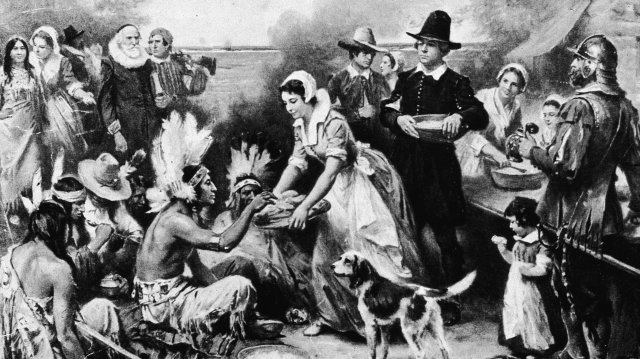

In addition, the imagery of the harvest season - pumpkins, corn, autumn foliage, and the ubiquitous turkey indelibly marks the holiday’s essential seasonality. Whenever we see a be-buckled Pilgrim and his natural prey, the turkey, or a generic American Indian amid the fruits of the harvest season, we are immediately put in mind of Thanksgiving.

Generations of artists and writers have used their stylized images to represent the holiday. The New England Thanksgiving is thought to have originated in 1621 with the Pilgrims, so it is fitting that the modern holiday adopt the hospitable Pilgrims and their Native American guests as its symbolic patrons. The “First Thanksgiving” is an etiologic tale, a story told to explain and define the holiday through an account of its alleged origins. However, those few facts have been so embellished through art, literature and commerce that it is the symbolic connotation of Thanksgiving, not its historical particulars, that shape our understanding of the American holiday. The meal, or something like it, did occur, and the attending Indian guests did join the colonists at dinner and in “recreations” over a three-day period. Like similar legends, the First Thanksgiving has a factual basis in history. The piéce de résistance was of course turkey, but every local foodstuff imaginable was included as well, thus initiating a Thanksgiving tradition of culinary excess that has continued to this day. The fifty-or-so Pilgrims who had survived the lethal “First Winter” of 1620/21 and Massasoit, with a royal retinue of 90 men, sat down to a huge outdoor feast prepared by the Pilgrim women. The popular perception of America’s Thanksgiving holiday might be summed up as “it all began with the Pilgrims.” After a successful harvest, so the story goes, Governor William Bradford declared an official thanksgiving day in November 1621 to which Massasoit, the principal sachem of the Wampanoag, was invited. This article is being reposted here with permission from the Alden House. The “First Thanksgiving” is an etiologic tale, a story told to explain and define the holiday through an account of its alleged origins.īelow is James Baker's article "The American Thanksgiving Holiday" which is an absolute must read to really understand the history of Thanksgiving.

The popular perception of America’s Thanksgiving holiday might be summed up as “it all began with the Pilgrims.”. But the most accurate and complete description of the true historical origins of Thanksgiving in one place are written by James Baker, historical author and researcher, former senior historian of the Plimoth Plantation and curator of the Alden House Historic Site. The historical documents to demonstrate the true origins of Thanksgiving are starting to become more accessible thanks to the internet, the Library of Congress and Google Books.

Thanksgiving was not started by the Pilgrims as we have popularly believed, but instead by another group from England, the Puritans.


 0 kommentar(er)
0 kommentar(er)
